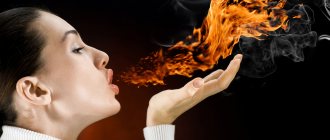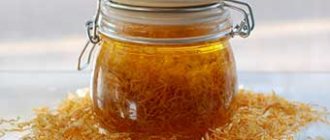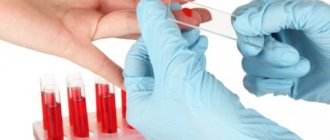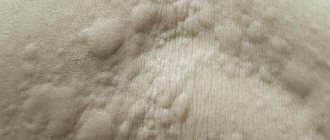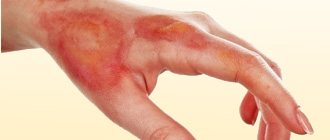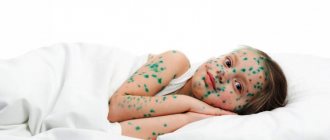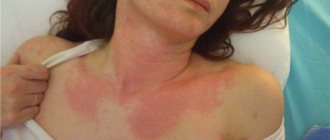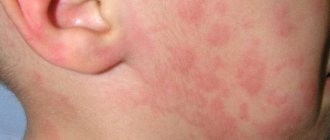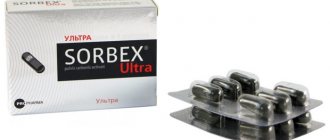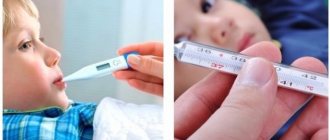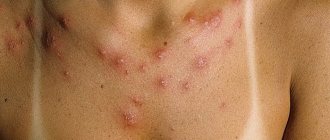How unpleasant any manifestation of allergies on the body is. It’s one thing when they are securely covered with clothes from people’s eyes, but when it comes to rashes on the arms and legs, there is no strength to endure it. Due to ignorance of the details about the problem, many neglect treatment, resulting in unpleasant consequences in the future. Why does allergy occur in these parts of the body, and how to deal with its manifestations? Please be patient - the answer will come very soon.
Urticaria on the hands requires qualified treatment
Causes of urticaria on the hands - the main etiological factors
Despite the fact that urticaria is classified as an allergic disease, scientists believe that this disease has a polyetiological origin (implies the presence of several main factors in the development of the pathology).
The main mechanism that leads to the appearance of rashes on the hands is the release of histamine. Histamine is a biogenic compound (amine) that functions as a mediator of inflammation, as well as allergic reactions. When an antigen (foreign protein or damaging factor) enters the body, antibodies (immunoglobulins) begin to be produced, which are fixed on mast cells, leading the body to a state of sensitization (sensitivity). Upon repeated contact with an antigen (allergen), an antigen-antibody complex is formed, as a result of which mast cells are destroyed. This leads to the release of large amounts of histamine. Acting on blood vessels, histamine causes increased capillary permeability, which leads to redness and swelling.
Antigens can be various compounds with which a person comes into contact (they can affect both directly the skin and penetrate into the blood). The most common triggers for urticaria on the hands are:
- medications;
- pet hair and saliva;
- food;
- insect bites;
- exposure to low and high temperatures;
- long-term exposure to UV rays.
In addition to the above factors, chronic infectious diseases, stress, excessive physical activity, friction and compression of the skin, and vitamin deficiency play a significant role. All these reasons lead to a decrease in the body's defenses and disturbances in the functioning of the immune system. And the allergen, in turn, is a provoking factor that triggers immediate hypersensitivity reaction mechanisms.
In childhood, the most common cause of urticaria on the hands is improper introduction of complementary foods and food allergies. Since the child’s immune system is not sufficiently developed, the body can react to any allergens - physical agents that make up powders, creams and other cosmetics for children. Often, urticaria appears as a result of contact with pollen, fluff, dust, synthetic soft toys, and rough clothing. And since a child’s skin is thin and delicate, allergic reactions in childhood occur somewhat more often than in adults.
Symptoms
The manifestation of symptoms depends on the state of the immune system, the presence of chronic diseases, and the frequency of colds:
- Itching - the first manifestation can be felt both during rashes and precede them 3-5 hours before.
- The spots gradually turn red and a slight swelling appears.
- Papules - hard formations, blisters with liquid, ulcers, scars; with urticaria due to the small size of the papules - scars no more than 1-1.5 mm; papules go through the above stages in 14-21 days only in case of infection; in other cases – 1-3 days, and in case of allergies to medications, no more than 7 days.
- Body temperature rises to 39 and above only with suppuration, burns with celandine, hogweed, honey, alcohol, irritation with salt, soda, fumes of acids, heavy (radioactive) metals; The rash turns into burns within 1-3 hours.
- Weakness, nausea - chemical fumes, close proximity of blood vessels and nerve endings, mental illness, increased blood and intracranial pressure.
- Rapid drying of the affected area - immune diseases affecting bone tissue, celandine juice, natural dry skin. Products containing methyl or propyl alcohol.
Clinical picture and main symptoms of the disease. Photo
Urticaria is an immediate type of hyperreactivity reaction (occurs no later than 24 hours after contact with the allergen). First of all, this pathological condition is characterized by the appearance of hyperemia (redness), swelling and blisters (bubbles that are filled with clear liquid). Patients often complain of pain and itching. As a result, scratches and scratches may also occur. In place of the blisters, erosions appear, which later become covered with crusts.
Urticaria is most often localized on the face or hands, since these parts of the body are most susceptible to the negative influence of damaging agents. On the hands, urticaria rash lesions can be located on the forearm, shoulder, wrists, palms, as well as on the fingers, on the back of the hand. They may appear as a collection of small blisters; in severe cases, the affected area may become covered in large blisters.
It should be remembered that any damage to the skin is an entry point for infection. And since hands come into most contact with the environment, the chance of a secondary infection (fungal, viral or bacterial) is very high. Therefore, it is necessary to begin treatment as soon as the first symptoms of the disease appear.
It should also be noted that urticaria can occur in an acute or chronic form. Urticaria is considered acute and lasts up to 6 weeks. This form is especially common in childhood and, in most cases, responds well to treatment. Chronic urticaria can last, like any other chronic disease, for years. In this case, periods of exacerbation and remission are observed. The most common cause of chronic urticaria is incorrect or untimely treatment for an acute condition.
Why is urticaria dangerous in childhood?
The clinical picture of this disease is the same as in adults, however, it has its own characteristics and risks that you need to be prepared for. If urticaria occurs in a child, there is a possibility of angioedema occurring in the future. This condition is characterized by swelling of the face and neck, swelling of the vocal cords also develops, which can lead to hoarseness, and in severe cases, if the laryngeal tissues swell, breathing may cease (even to death). Often, with severe forms of urticaria, the general condition of the child may also be affected. This manifests itself in the form of weakness, dizziness, headache, and fever. Also, in childhood, a secondary infection occurs more often, since children do not have sufficient hygiene skills.
Root causes of itching
Stress can affect more than just your emotional health. The reaction to overexertion causes a wide range of physical symptoms, such as rashes, dystrophic changes in the nails, and exacerbation of chronic diseases. Rashes can appear on any part of the body.
Scientists have proven that strong emotional experiences are associated with the appearance of acne or nettle fever. Areas of skin affected by dermatitis are red, inflamed, and swollen.
The spots can be the size of a pencil tip or the size of a five-ruble coin
People with allergies, neurodermatitis or sensitive, easily irritated skin should pay attention to intensive care
Diagnostics
Diagnosis and treatment of this condition is carried out by dermatologists, allergists, immunologists and pediatricians (if the disease appeared in childhood). In addition to consulting these specialists, it is also necessary to undergo the following examinations:
- general blood and urine analysis;
- blood chemistry;
- determination of the amount of immunoglobulin E;
- allergy skin tests (if the allergen cannot be identified);
- consultations with specialized specialists (to exclude chronic diseases of internal organs).
How to treat urticaria on the hands: basic principles of therapy
Since the main component of the pathogenesis of urticaria is an allergic reaction, first of all, it is necessary to exclude or limit contact with the allergen. This is very easy to do if the disease is acute. In case of long-term (chronic) course of the disease, it is necessary to carry out allergy skin tests. You should also follow a hypoallergenic diet (exclude coffee, alcohol, citrus fruits, sweets, seafood, milk, eggs and other strong allergens).
Traditional Treatments
Drug treatment is the most effective component of urticaria treatment. Pharmacotherapy is carried out according to several principles:
- if urticaria progresses rapidly, then antihistamines (Suprastin) are administered intravenously as an emergency medical aid;
- if the allergen enters the gastrointestinal tract, give an enema and rinse the stomach with cool water;
- sorbents are prescribed that help toxins be eliminated from the body faster (activated carbon, Smecta);
- for desensitization, administration of sodium thiosulfate is indicated (for severe forms of the disease);
- prescribe systemic antihistamines (Suprastin, Loratadine, Eden tablets, Fenistil drops);
- glucocorticosteroids are prescribed only under the supervision of a physician if other treatment methods are ineffective (Prednisolone, Hydrocortisone);
- cell membrane stabilizers (Ketotifen) are also prescribed;
- Immunomodulators are often used (during the recovery period);
- It is recommended to drink plenty of warm drinks throughout the illness;
- to strengthen blood vessels and reduce their permeability, the doctor may prescribe calcium and vitamin C supplements;
- in severe cases, diuretics and laxatives (in combination with sorbents) are also added to therapy - this makes it possible to most effectively remove the toxin from the body.
Pediatricians recommend using drops rather than tablets for the treatment of urticaria in children - this is how the effectiveness of treatment is achieved. This is due, first of all, to the fact that young children often refuse to take pills.
However, not only systemic drugs are used, but also local agents, which include:
- Fenistil ointment (can be used from the second month of a child’s life);
- hydrocortisone ointment (only under the supervision of a doctor and for a limited course);
- Gistan cream (based on natural ingredients, therefore suitable for the treatment of urticaria on the hands in early childhood);
- Elokom, Advantan, Skin-Cap (these ointments, like hydrocortisone, are hormonal, so there is no need to use them without first consulting a doctor).
In any case, the volume and duration of pharmacotherapy depend on a large number of factors: gender, age, severity and duration of the disease, and the presence of concomitant pathologies. Only a specialist can evaluate these indicators, so if hives appear, it is recommended to immediately seek medical help.
Traditional medicine methods
In alternative medicine, there are a large number of folk recipes that can help treat urticaria on the hands. However, it should be remembered that many of these drugs can affect the immune system and cause allergic reactions. Therefore, you should consult your doctor before using them. The most popular and effective traditional medicine that can be used for urticaria, both in adults and children, are:
- decoction of nettle leaves. To prepare it, you should take 1-2 tbsp. dry leaves and pour 400-500 ml of boiling water. Leave for an hour and take 1-2 tbsp. 4-5 times a day after meals.
- celery juice. It is recommended to chop and squeeze the juice from celery, after which this product can be added to food and drinks.
- herbal infusion. It is necessary to take the following herbs in equal parts (1 tablespoon each): oregano, chamomile, coltsfoot, string, licorice, valerian root. All ingredients must be poured into 1 liter of boiling water and allowed to brew for 1-2 hours. Drink 1-2 tsp. 3-5 times a day before meals.
- calamus root powder. Drink 0.5-1 tsp once a day (preferably in the evening) with a glass of warm water.
Remember that traditional medicine methods can only complement drug therapy, because they effectively relieve symptoms such as pain, itching and burning. However, first of all, you need to consult a doctor and find out the cause of this condition.
Skin care for hives
It is very important not only to follow all doctor’s instructions, but also to properly care for the affected skin. In order to speed up the recovery process, experts recommend adhering to the following recommendations:
- You need to bathe, but it is better to do this in herbal decoctions that have an anti-inflammatory effect. Do not rub or touch the affected skin of your hands with your hands. There is no need to wipe the affected areas with towels - just blot the skin with a soft cloth.
- you should not visit public pools or swim in bodies of water, as this can lead to infection;
- Do not stay in direct sunlight for a long time and do not sunbathe;
- during the healing stage (after crusts have formed), you can lubricate the skin with baby cream;
- If hives appear on a child’s hand, the nails should be trimmed short to minimize the chance of a secondary infection.
Itchy skin: what medications can you take?
You can get rid of nervous itching of the skin using traditional methods of treatment. The following tools are used for this:
Itching of the skin from nerves does not cause a pleasant sensation for anyone, and therefore everyone strives to get rid of the disease as soon as possible. With it, you can take sedatives, and if it accompanies you inconsistently, it makes sense to drink valerian extract.
Doctors usually prescribe antihistamines in combination with sedatives to help get rid of itching.
If you go to the doctor and say: “Doctor, I’m itching because of my nerves,” and he diagnoses “itching due to nerves,” then, most likely, you will be prescribed:
- Sedatives.
- Soothing herbal teas.
- Baths with sage, oak bark, chamomile and lavender.
- Aromatherapy.
- Breathing exercises and meditation.
- Lack of sleep causes nervous disorders and depression.
- Traces of scratching and scabies on the body become a sight that arouses the hostility of others.
- Expansion of localization in the advanced stage of scabies leads to polymorphism of the genitals, mammary glands, inner thighs, buttocks, and torso.
Treatment of the disease is aimed at destroying the pathogen while simultaneously relieving the side symptoms it causes.
- The early stage allows:
- reduce the use of medications;
- prevent mass infection of others.
Moderate and severe form:
- lead to the use of complex drugs;
- Treatment is carried out according to complex schemes.
The main method of treatment is rubbing ointments into the skin or applying special sprays. Intolerance to ointment components or an allergic reaction may cause the use of tablets.
- Ivermectin begins to act after 4 hours. It has a positive effect on many parasitic diseases. Toxic. Large group dosage restrictions due to side effects:
- nausea, vomiting;
- disruption of the gastrointestinal tract;
- decreased concentration;
- dizziness and loss of consciousness;
- possible manifestation of lymphadenopathy.
Prohibited for pregnant women, those suffering from central nervous system diseases, and children under 6 years of age.
- pregnancy;
- breastfeeding;
- disorders of the cardiovascular system, hypertension.
If the disease has not yet become widespread or scabies needs to be prevented, then it is much safer to use traditional medicine.
Treatment at home should be carried out in compliance with the basic rules, regardless of what medicine you use:
- All family members or cohabitants should always be treated, regardless of whether they have symptoms.
- All family members or cohabitants should always be treated, regardless of whether they have symptoms.
- All fabric items and household equipment must be subjected to thorough hygienic treatment.
- For the entire period of treatment, a strict ban on the patient’s communication with people living separately from him and home quarantine must be observed.
Before replacing medications with folk remedies, you should definitely consult your doctor, as he will prescribe the required duration of the course.
If your skin itches constantly when you are nervous, you will need stronger medications, a prescription for which you can only get from a doctor. If you take medications without the supervision of a specialist, you risk provoking allergic reactions or simply getting used to the medications.
Doctors usually prescribe antihistamines in combination with sedatives to help get rid of itching.
Prognosis and complications
As a rule, if treatment is started on time, the prognosis for the course of the disease is favorable. Complications arise from improper and untimely treatment. The most common consequences of urticaria on the hands include:
- chronicity of the process;
- secondary infection;
- Quincke's edema;
- anaphylactic shock;
- development of other allergic diseases (for example, atopic dermatitis).
The complications described above are classified as serious conditions that require specialist intervention. Therefore, to avoid their occurrence, you need to contact a medical institution if a child or adult has the first symptoms of the disease.
Treatment methods
In order for the treatment of pathology on the palms to be effective, it is very important to establish the provoking factor and eliminate any contact with it. There are also medications that can help keep the symptoms of the disease under control. In most cases, doctors prescribe antihistamines to help alleviate the symptoms of the disease - loratadine, cetirizine, fexofenadine, etc.
The most common side effect after taking antihistamines is increased drowsiness. Therefore, doctors prefer to prescribe new generation drugs that do not cause such problems.
IMPORTANT!
To treat allergies, our readers successfully use Anna Leonovich’s method. Read more >>>
Homemade formulations can be used to relieve the symptoms of hives on the hands. A decoction based on celandine, sage, chamomile, string, St. John's wort and valerian is considered an effective remedy. The resulting composition is added to the bath, which should be taken for 5-10 minutes.
Prevention: can hives be prevented?
Since the tendency to allergic reactions is often due to heredity and family history, the occurrence of urticaria cannot be completely excluded. If the disease has already occurred, then you should follow the doctor’s recommendations and also avoid contact with the allergen. To prevent the occurrence of hives on the hands, it is recommended:
- Healthy food;
- avoid stressful situations;
- do not expose the skin to prolonged exposure to traumatic agents (mechanical: friction, compression; physical: low or high temperatures, wind, UV radiation);
- use only certified and high-quality hypoallergenic cosmetics (cream, soap);
- maintain a drinking regime to avoid dry skin;
- if dryness and flaking are observed, moisturize the skin of your hands with emollients or fatty creams;
- protect the skin of your hands from insect bites;
- when contacting household chemicals, you should wear gloves;
- observe the rules of personal hygiene;
- Drug therapy for other diseases should be agreed with a doctor; you should not self-medicate.
Urticaria is a fairly common disease that can be cured permanently in a short time. However, if you do not seek medical help, this pathological condition can lead to a number of unwanted complications, and some of them can be life-threatening, especially in childhood.
